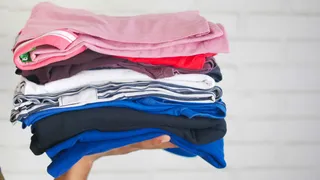With a lot of organization, a little science and the right tools, you need not drown in yacht laundry.
Laundry management on board demands military precision, organization and attention to detail. With steady loads of crew uniforms mixed with guests’ delicate designer garments, implementing a good system is crucial for maintaining a seven-star service (and avoiding laundry disasters).
Organizational Systems
Both guests and crew can agree that receiving the wrong items, losing garments or having their beloved pieces destroyed by poor handling is unacceptable. To avoid turning your laundry room into a garment graveyard, you need to implement the following easy-to-understand system:
- Get different-colored laundry bags and either iron on labels or embroider them with crew positions. Each position should have a designated color. If you can’t find matching laundry bags in different colors, begin with colored pins and match either the crew member’s position to a press-on color label or embroider to match the pin color.
- Purchase premium laundry bags that look different from crew laundry bags for guest cabins. Have these embroidered with the yacht cabin’s creative name or labeled: VIP, Master, Twin, etc.
- Acquire colored pins that match the laundry bag colors, plus additional colors to pin inside guest bags.
- For uniforms, you can have custom laundry stamps made with crew positions, use matching colored thread from the laundry bags to sew small stitch-on labels, iron on labels, keep their designated color pin on the tag
or create custom “snappy tags” that attach to labels. - Apply the same labeling system to all guest and crew linens.
- Create a laminated reference table that displays crew position, cabin number, name, color code (with space to attach colored pin samples) and hang it in the laundry room.
Tracking and Documentation
As you are color-tagging guest laundry, you should track all guest items. The traditional approach utilizes printed charts you fill in by hand that record cabins, garment descriptions, owner details, check-in times, handling crew, check-out times and special care instructions — proven more efficient for smaller crews managing quick turnarounds. For vessels with more stew-power, digital tracking through platforms such as Airtable offers advanced features such as photo documentation, automatic time logging and digital signatures.
Invest in a Great Iron
The difference between a good iron and a great iron is a major time saver. The Laurastar Lift Xtra Steam Iron has a proven track record as a beloved stew essential. Taking care of your iron saves time, prevents disasters and ensures a crisp, professional finish every time:
- Use distilled water only to prevent mineral build-up and rust stains.
- If distilled water isn’t available, use filtered or purified water.
- Empty the water tank every night to prevent rust and leaks.
- Descale every two to three weeks or immediately if the iron spits water or leaves white/brown marks.
- Always test your iron before using it on clothing by first ironing a drop towel.
Sorting
After you’ve collected laundry, tagged all clothing and thoroughly checked pockets for stray items, it’s time to master the art of sorting. Forget the basic lights, colors, and darks system — that’s for amateurs. To optimize laundry efficiency, create these essential piles:
- Hang-dry clothing (subdivided into whites, colors, darks)
- Machine-dry clothing (subdivided into whites, colors, darks)
- Hang-dry uniforms (subdivided into whites, colors, darks)
- Machine-dry uniforms (subdivided into whites, colors, darks)
- Hand-wash items
- Socks and underwear
- Workout clothing (too smelly to mix)
- Dry clean only items
- Clean sheets and towels
- Stained sheets and towels
- Stained clothing
- Stew cleaning rags
- Galley rags
Create a “Label Reading 101” station with charts showing what each symbol means and make it a rule: nothing gets processed without a label check.
Become a Stain Scientist
After you’ve sorted your laundry and started your first loads from the hang-dry only piles of clothing (since they take longer to dry), you’re going to begin your stain-treating journey.
- Wine Away for red wine stains
- Club soda helps remove red wine and blood stains
- Vanish/OxiClean soak for deep stains; caution: can bleach dark/delicate fabrics
- Colour Catcher prevents color bleeding
- Whink Stain Remover removes yellow sweat and sunscreen stains
- Napisan whitens dingy/gray fabrics, removes tough stains
- Ariel with Actilift Color prevents color transfer
- K2r spot lifter effective for oil stains
- Baby powder or cornstarch absorbs grease and oil stains before washing
- Ecolab rust remover removes rust stains
- Hydrogen peroxide treats sunscreen, mustard, grass and blood stains
- Baking soda deodorizes, softens water and boosts detergent
- White vinegar neutralizes odors, acts as a natural fabric softener, aids in stain treatment.
- Dove bar soap works on mascara, foundation, oil-based stains and mystery stains
- Aerosol hairspray removes pen marks
- Toothpaste (non-gel, white) removes scuffs from white-soled shoes
- Meat tenderizer breaks down underarm/sweat stains (enzyme-based)
- Dishwashing liquid (Dawn or similar) effective for grease and oil-based stains
Cut Some (Sheet) Corners
If time is of the essence, don’t be afraid to iron sheets directly on the bed. If you have a little extra time, leave the sheets slightly damp from the dryer and press them right there for a crisp, smooth finish.
Many stews swear by Downy Wrinkle Releaser, but for scent-sensitive owners and guests, fill an old Downy spray bottle with water, and it will work just as well on a tightly made bed. Always iron the pillowcases — they frame the bed and make all the difference in a polished, luxury look.

